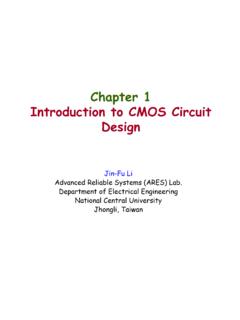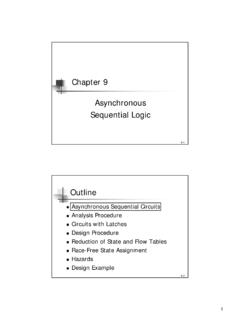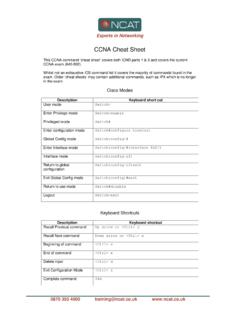Transcription of Chapter 4 Low-Power VLSI DesignPower VLSI Design
1 Chapter 4. Low-- power vlsi Design Low Jin-Fu Li Advanced Reliable Systems y ((ARES)) Lab. Department of Electrical Engineering National Central University Jhongli, Taiwan Outline Introduction Low-Power Gate-Level Design Low-Power Architecture-Level Design Algorithmic-Level power Reduction RTL Techniques T h i for f Optimizing O i i i power P. National Central University EE4012 vlsi Design 2. Introduction Most SOC Design teams now regard power as one g concerns of their top Design Why Low-Power Design ? Battery lifetime (especially for portable devices).
2 Reliability power consumption Peak power p Average power National Central University EE4012 vlsi Design 3. Overview of power Consumption Average power consumption Dynamic y p power consumption p Short-circuit power consumption Leakage power consumption Static power consumption D. Dynamic i power di dissipation i ti d during i switching it hi Cinput interconnect Cdrain Cinput National Central University EE4012 vlsi Design 4. Overview of power Consumption Generic representation of a CMOS logic gate for gp switching power calculation VA.
3 PMOS. VB network Vout VA nMOS C drain Cint erconnect Cinput VB network 1 T /2 dVout T dVout Pavg [ Vout ( Cload )dt (VDD Vout )(Cload )dt ]. T 0 dt T /2 dt National Central University EE4012 vlsi Design 5. Overview of power Consumption The average power consumption can be expressed as 1. Pavg 2. C load V DD C load V DD. 2. f CLK. T. The node transition rate can be slower than the clock rate. To better represent this behavior, a node transition factor f ( T ) should be introduced Pavg T C load V DD. 2. f CLK. The switching power expressed above are derived by taking into account the output node load capacitance National Central University EE4012 vlsi Design 6.
4 Overview of power Consumption VA VA. Vinternal VB. VB Cinternal Vinternal Vout VA VB Cload Vout The generalized expression for the average power dissipation can be rewritten as # ofnodes . Pavg Ti C iV i V DD f CLK.. i 1 . National Central University EE4012 vlsi Design 7. Gate--Level Design Technology Mapping Gate The objective of logic minimization is to reduce the boolean function. For Low-Power Design , the signal switching activity is minimized by restructuring a logic circuit The power minimization is constrained by the delay, however, the area may increase.
5 During this phase of logic minimization, the function to be minimized is . i P i (1 P i ) C i National Central University EE4012 vlsi Design 8. Gate--Level Design Technology Mapping Gate The first step in technology mapping is to decompose each logic function into two-input gates The objective of this decomposition is to minimizing the total power dissipation by reducing the total switching activity ti it A B C D 0. 5. A. B. C A D B C D 0. 5 National Central University EE4012 vlsi Design 9. Gate--Level Design Phase Assignment Gate High activity node High activity node A.
6 A. B. B. C. C. National Central University EE4012 vlsi Design 10. Gate--Level Design Pin Swapping Gate a b c d a b c d d a Switchin Switching activityy c b ng activity b c a d d a c b b a c d National Central University EE4012 vlsi Design 11. Gate--Level Design Glitching power Gate Glitches spurious transitions due to imbalanced path delays A Design has more balanced delay paths has fewer g glitches,, and thus has less power p dissipation p Note that there will be no glitches in a dynamic CMOS. logic g A. A. B. B D.
7 C. E D. C. E. National Central University EE4012 vlsi Design 12. Gate--Level Design Glitching power Gate A chain structure has more glitches A tree structure has fewer glitches A. B. C Chain structure D. A. B Tree structure C. D. National Central University EE4012 vlsi Design 13. Gate--Level Design Precomputation Gate REG REG. Combinational Logic R1 R2. REG REG. Combinational Logic R1 R2. Precomputation Logic g National Central University EE4012 vlsi Design 14. Gate--Level Design Precomputation Gate A<n-1>. A<n 1> REG 1-bit Comparator B<n-1> R1 (MSB).
8 REG. A<n-2:0>. R2. (n-1)-bit REG. Enable Comparator R4. Precomputation logic F. REG. B<n-2:0>. R3. National Central University EE4012 vlsi Design 15. Gate--Level Design Gating Clock Gate D Q D Q D Q D Q. Fail DFT rule clk checking T. Add control pin D Q D Q D Q D Q to solve DFT. violation problem clk National Central University EE4012 vlsi Design 16. Gate--Level Design Input Gating Gate f1. clk +. select l t f2. National Central University EE4012 vlsi Design 17. Clock--Gating in Low- Clock Low-Power Flip Flip--Flop D D Q.
9 CK. Source: Prof. V. D. Agrawal National Central University EE4012 vlsi Design 18. Reduced-- power Shift Register Reduced D D Q D Q D Q D Q. multiiplexer Output D Q D Q D Q D Q. CK(f/2). Flip-flops are operated at full voltage and half the clock frequency. Source: Prof. V. D. Agrawal National Central University EE4012 vlsi Design 19. power Consumption of Shift Register 16-bit shift register, 2 CMOS. P = C'VDD2f/n Deg. Of D Freq F power P 10. parallelism (MHz) ( W). 1 33 0. 1535. ed power 2 887. 4 8 25. 738 05. ormalize No C.
10 Piguet, Circuit and Logic Level Design pages 103-133. Design , 103 133 in WW. Nebel 00. and J. Mermet (ed.), Low power 1 2 4. Design in Deep Submicron Degree of parallelism, n Electronics Springer, Electronics, Springer 1997. 1997. Source: Prof. V. D. Agrawal National Central University EE4012 vlsi Design 20. Architecture--Level Design Parallelism Architecture 16 16. A R A R. 32 16 32. 16x16 16x16. fref fref/2. multiplier multiplier 16 R. B R. M 32. U. fref fref/2 X. Assume that With the same 16x16 R. multiplier, the power supply can fref be reduced from Vref to 16x16.



![Training Course of Design Compiler [相容模式]](/cache/preview/c/f/6/f/4/1/7/2/thumb-cf6f4172c80a30be0667109e5a50ce98.jpg)
![hspice tutorial.ppt [相容模式] - ee.ncu.edu.tw](/cache/preview/0/1/e/d/5/5/6/4/thumb-01ed55640fe3958cfb144af3846e1fcf.jpg)









